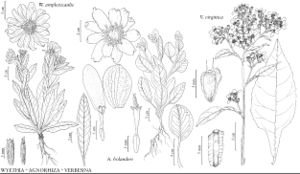Agnorhiza
Phytologia 85: 19. 1999.
| Taxon | Illustrator ⠉ | |
|---|---|---|
 | Wyethia amplexicaulis Agnorhiza bolanderi Verbesina virginica | John Myers John Myers Yevonn Wilson-Ramsey |
Perennials, 5–60 (–100) cm (taproots relatively massive; caudices sometimes branched). Stems erect and branched (mostly distally), or decumbent (and seldom branched distally). Leaves basal and cauline (basal usually scalelike on flowering-stems, well-formed on nonflowering shoots); alternate; petiolate; blades (3-or 5-nerved or pinnately nerved), cordate-ovate, deltate, deltate-triangular, ovate, ovatelanceolate, or suborbiculate, bases broadly cuneate, subcordate, or truncate, margins entire or dentate to crenate, faces glabrous or hairy (often glanddotted). Heads radiate or discoid, borne singly (terminal) or in ± racemiform arrays. Involucres campanulate to ± hemispheric, 12–40 mm diam. Phyllaries persistent, (8–) 12–26+ in 2–3+ series (subequal to unequal, outer usually surpassing inner). Receptacles flat to convex, paleate (paleae persistent, conduplicate, chartaceous). Ray-florets 0 or (1–) 5–21+, pistillate, fertile; corollas yellow. Disc-florets 50–150+, bisexual, fertile; corollas yellow, tubes shorter than cylindric throats, lobes 5, lance-deltate (style-branches stigmatic in 2, barely distinct lines, appendages filiform). Cypselae ± prismatic, 3–4-angled (faces glabrous or strigillose); pappi usually persistent, coroniform (± lacerate, sometimes with 1–4 teeth or scales), sometimes 0. x = 19.
Distribution
Calif., nw Mexico
Discussion
Species 5 (5 in the flora).
Selected References
Lower Taxa
Key
| 1 | Plants (5–)15–30(–45+) cm; stems decumbent, seldom distally branched; cauline leaves: blades ovate, suborbiculate, elliptic, rounded-deltate, or oblong; involucres ± campanulate, 12–25(–30+) mm diam | > 2 |
| 1 | Plants (20–)40–100 cm; stems erect, usually distally branched; cauline leaves: blades deltate, ovate, or ovate-lanceolate; involucres ± hemispheric, (15–)20–40 mm diam | > 3 |
| 2 | Leaves glabrous (shining, finely gland-dotted, glutinous); heads held among or beyond leaves; ray florets (7–)8–12, laminae (12–)20–30(–35) mm; cypselae 7–9 mm; pappi 0 or coroniform, 0.1–0.3 mm | Agnorhiza bolanderi |
| 2 | Leaves silky-villous to strigillose, glabrescent; heads in axils of (and overtopped by) leaves; ray florets 5–8(–9), laminae 8–18 mm; cypselae 9–10 mm; pappi coroniform, 1–1.5+ mm | Agnorhiza ovata |
| 3 | Ray florets 0 or 2–3 | Agnorhiza invenusta |
| 3 | Ray florets 10–23 | > 4 |
| 4 | Leaf blades: faces tomentulose to pilosulous (and gland-dotted); cypselae 8–12 mm; pappi (0.5–)1–2(–3) mm | Agnorhiza elata |
| 4 | Leaf blades: faces sparsely hispid or scabrous (and finely gland-dotted, green, shin-ing, often vernicose); cypselae ca. 6 mm; pappi 0.1–1 mm | Agnorhiza reticulata |
"broader" is not a number.